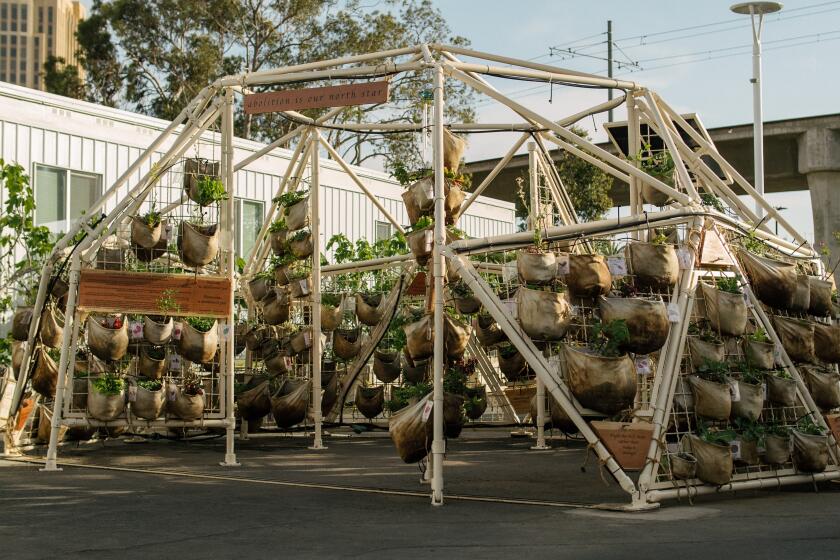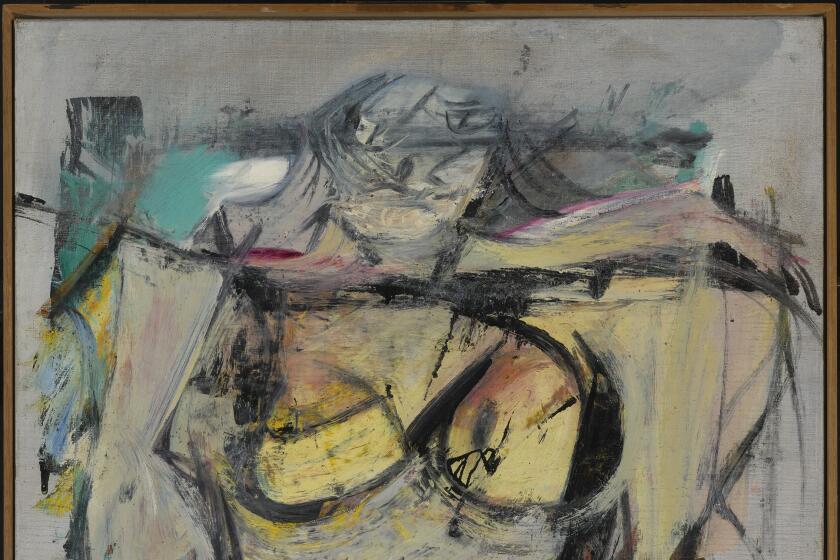Inside the Getty’s rigorous effort to fix a 500-year-old broken masterpiece
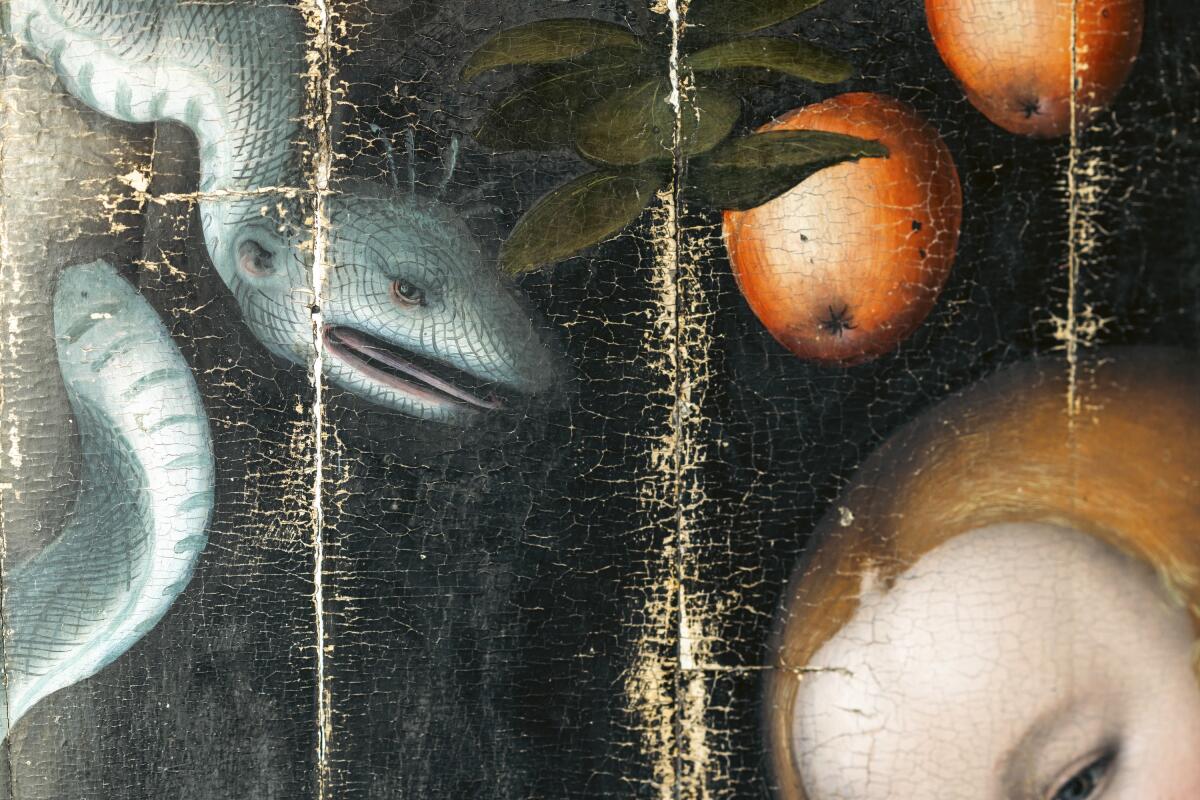
- Share via
After 2½ years of rigorous, sometimes hair-raising effort, the conservation studio at the J. Paul Getty Museum has completed work on one of the key treasures of European art in Los Angeles. Lucas Cranach the Elder’s pair of panel paintings, “Adam” and “Eve” (circa 1530) at the Norton Simon Museum, beautifully restored, go on view Tuesday at the Getty in a special three-month exhibition, before returning to the duo’s permanent home in Pasadena.
The German Renaissance masterpiece is one of those great have-your-cake-and-eat-it-too images. Cranach (1472-1553), a pal of Martin Luther, was a signature artist of the Protestant Reformation — court painter of the Elector of Saxony, a prince of the Holy Roman Empire. Adam and Eve’s cautionary tale of humanity’s fall from grace in the Garden of Eden could provide a patron the public veneer of biblical piety. At the same time — and ideal for an artist whose capacities for sophisticated decorative design were unmatched among German artists in his day — those two life-size naked bodies offered something more: they’re delectable to ogle, whether curvaceous Eve or buff Adam, or the imaginative thought of carnal knowledge between them.

Each holds a tantalizing apple, plucked from the tree of knowledge of good and evil. Eve’s long, spiraling strands of hair blow out into a radiant aureole behind her shapely body, as if it were a starburst halo framing a divinity. For his part, Adam twiddles his own curly locks with one raised hand, seemingly in nervous anticipation. Cranach sure knew how to deliver cultivated sensuality, and clients ate it up.
He was so successful, in fact, that some 50 versions of the Bible story were produced by his large studio over the years. The Pasadena pair, together with the stellar example at the Uffizi Museum in Florence, Italy, resides at quality’s peak, surely all by Cranach’s own hand. But a lot can happen to a work of art over the course of half a millennium. Until now, Pasadena’s paintings were physically something of an unnerving if well-disguised mess.
After a demanding program that included a gasp-inducing repair of the two cracking, 500-year-old limewood panels, Getty senior conservator Ulrich Birkmaier and his team stabilized the paintings, while bringing the images back to something close to what they likely were when they left the artist’s big and busy workshop in Wittenberg, about 70 miles southwest of Berlin, in the 16th century. I saw the Cranach panels three times in the conservation studio. During an interview when final touches were being applied just days prior to the public unveiling, Birkmaier described the 30-month job as “the most labor-intensive” of his career.
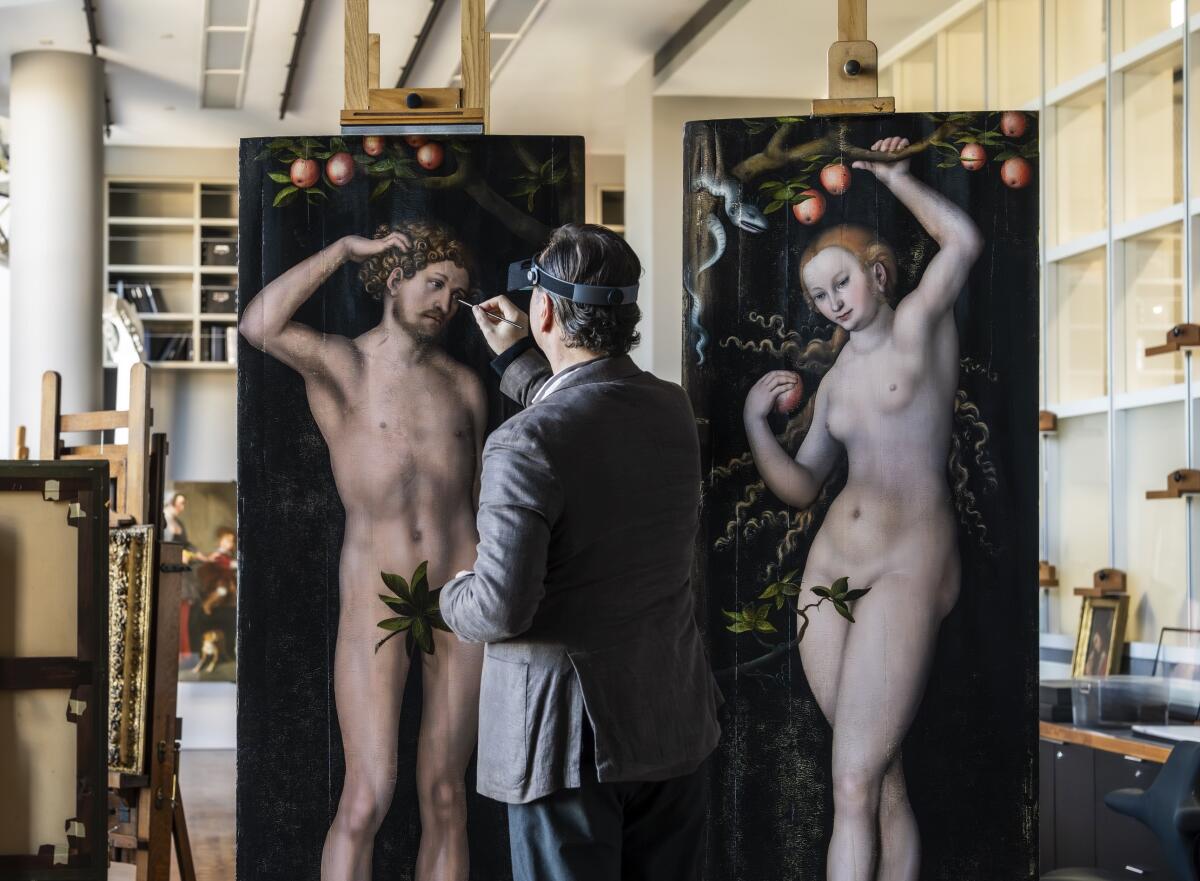
Surprisingly, he said, given the stature of the artist and the probable importance of a patron for such a lavish pair of six-foot paintings, the panels are composed of low-grade wood. Tall narrow slats of limewood (or linden) were butt-joined with glue. Individual slats have lots of knots, many of them requiring removal and replacement with inserts in Cranach’s workshop, and some during subsequent conservation.
As a natural material, wood both expands and contracts, reacting to changes in temperature and humidity. The long linear joints and the edges of scattered repairs are sites of significant flaking and paint loss.
Getty’s PST Art collaboration (previously known as Pacific Standard Time) is set to open next fall with a vast array of public programming set to examine the intersection of art and science.
Woodworms also had a field day. Tracks from the beetle larvae are visible to the naked eye and, more deeply, to X-rays. Dense clusters of them in the lower registers suggest that the panels might even have been standing in water at some point in time, softening the wood and inviting infestation. Chunks of wood were missing along ragged bottom edges, which required complicated replacement. Parts of his and, especially, her toes needed repainting from scratch, with the intact imagery in the Uffizi pair used as a helpful guide to the painterly pedicure.
The panels are also unusually thin. They had been fitted with cradles, a once-common conservation technique for paintings on wood that is no longer recommended. A cradle, a wooden grid affixed to the back, has horizontal or vertical slats glued in place and perpendicular strips left to float. Together they hold the panels firm while allowing just slight movement, trying to prevent warping.
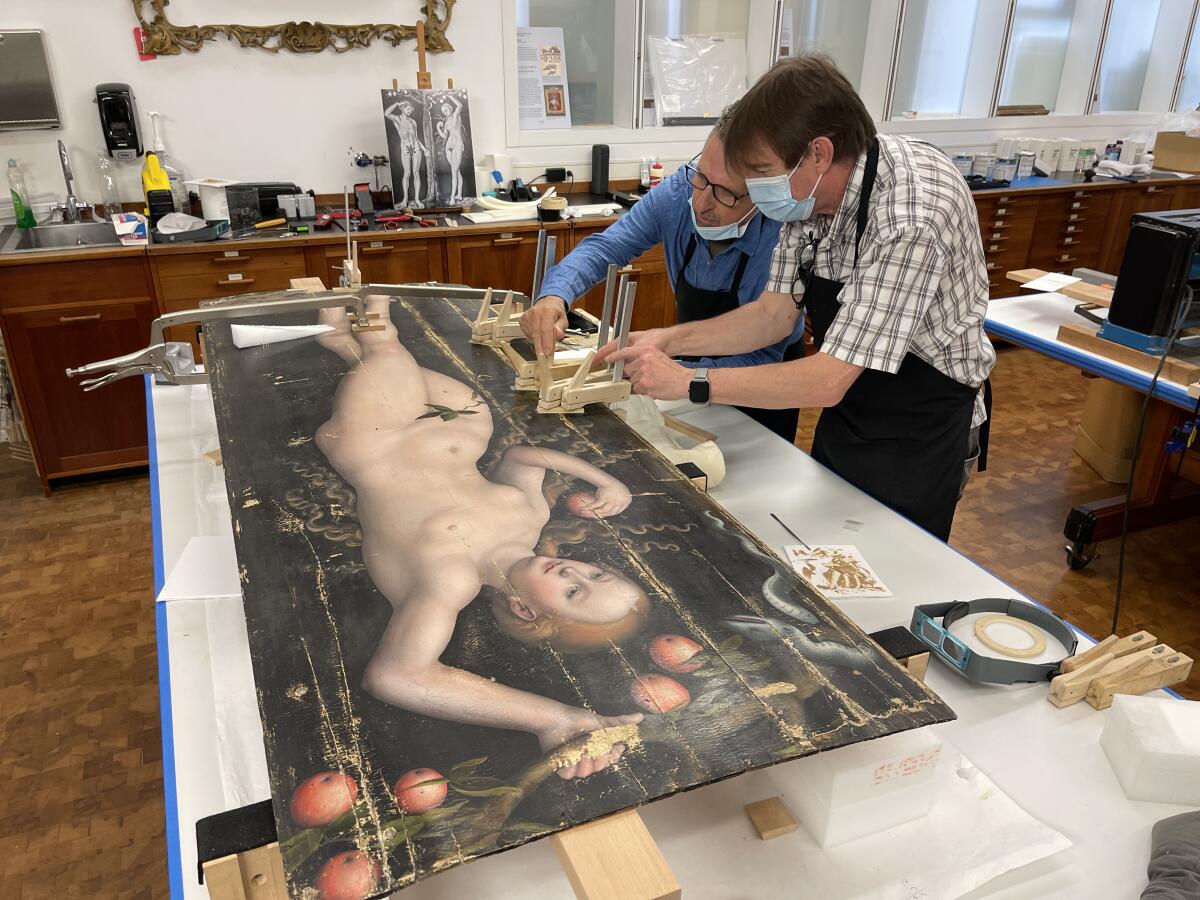
Removal of the Cranach paintings’ cradles at some unknown date in history required a process of scraping and planing the back. “Adam” and “Eve,” although painted to be shown separately, were also once joined together to form a single picture, with pins inserted along inner edges to hold the two together. Now detached, the exposed pinholes appear cut in half, revealing just how much the panels’ original thickness was reduced.
Then there was the disfiguring salvo of possible gunfire.
During World War II, German Reichsmarschall Hermann Goering — founder of the Gestapo, head of the Luftwaffe, second only to Hitler in the Nazi command, morphine addict and pathologically driven art collector — stole nearly 1,500 European paintings, many from Jewish families and galleries across the continent, mainly for personal use at Carinhall, his palatial country estate. (“I intend to plunder and to do it thoroughly,” he boasted.) Cranach’s “Adam” and “Eve” were among them — two of the finest of Goering’s more than three dozen looted paintings by the German artist.
Four 2023 gifts, including a Goya portrait and a David Hockney landscape, expand the Huntington’s paintings collection.
Loaded onto a train for transport to Germany from Amsterdam, where they were part of the massive stolen inventory of art dealer Jacques Goudstikker, the panels may have been shot up during an Allied attack, Birkmaier explained. Hard proof awaits, but metal shards and what appear to be bullet holes in the Eve panel were revealed by radiography.
Birkmaier removed layers of yellowed varnish from the surfaces, as well as in-painting from earlier restorations. The vibrancy of Cranach’s original oil colors was exposed, together with scarred areas of paint loss. Before addressing painterly issues, the objects’ architecture needed to be fixed.
To stabilize the wooden panels, he turned to George Bisacca, conservator emeritus at New York’s Metropolitan Museum of Art, and José de la Fuente of Madrid’s Museo del Prado. Participants in Getty’s 2008-2018 Panel Painting Initiative, studies designed to expand knowledge in conservation techniques specific to paintings on wood, Bisacca and De la Fuente had developed an unprecedented — and rather scary — method.
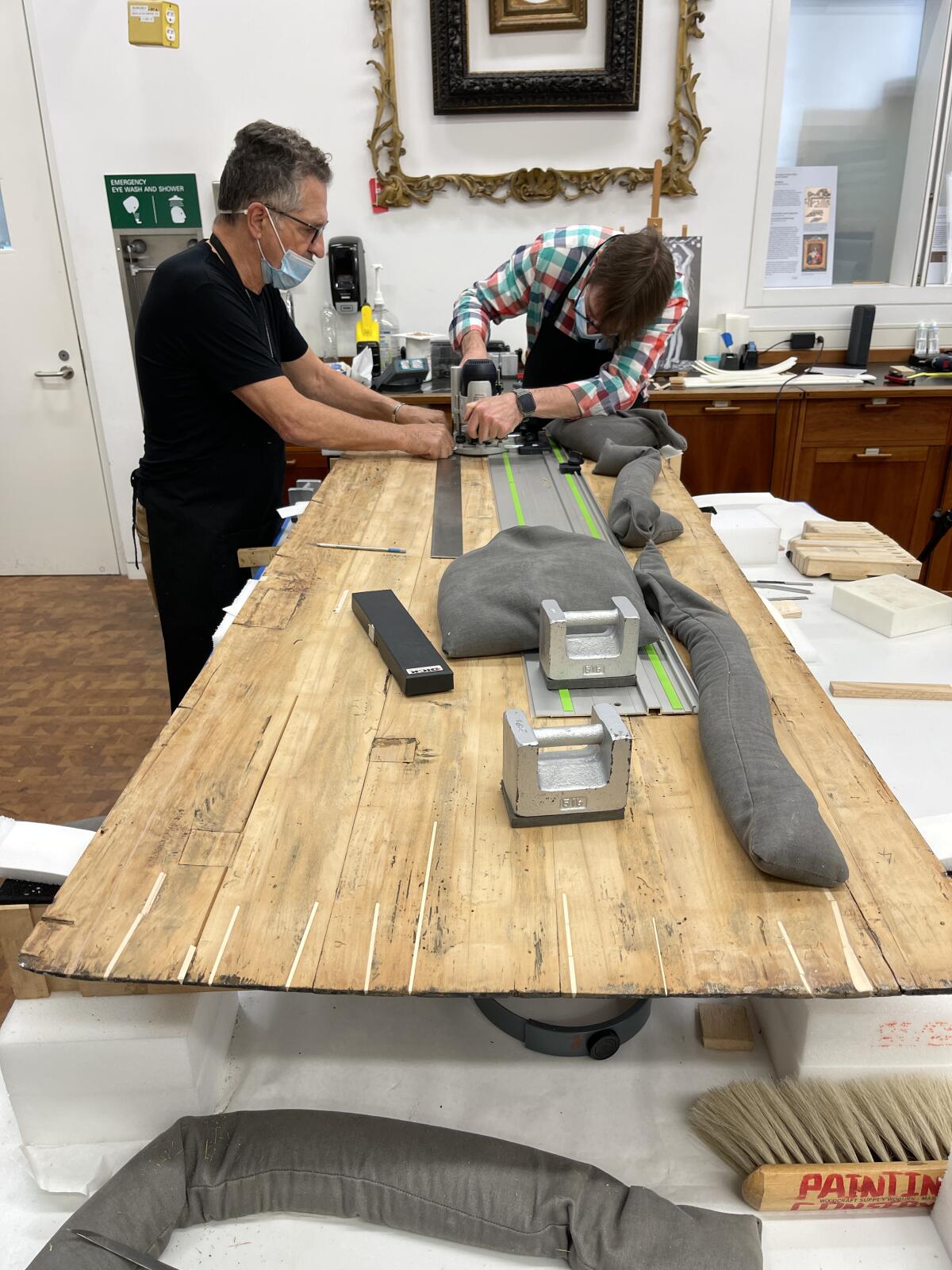
The panels, laid face-down and flat on a worktable, were subject to an unexpected type of cleaning. A precision router — the electric power tool, not the Wi-Fi internet extender — traced the vertical cracks, smoothing and leveling hairline breaks in the wood.
Because wood’s thickness is not uniform, the most exacting part of the exercise was to not go too deep, which could puncture the painted surface on the other side, ruining the picture. Using a delicate magnetic caliper employed by violin makers to measure in millimeters an instrument’s walls and veneers, the conservators tracked the wood’s thickness at short intervals along the crack. In essence, a three-dimensional map was created for their invasive micro-maneuver.
When finished, each skinny routed channel also became a precise template for carving a narrow piece of fresh basswood — the American equivalent of European linden — of exactly the same dimensions. Rather like an orthopedic pin for a broken bone, a made-to-measure basswood “implant” was then inserted into each crack. The once-broken back of the panel is now fully intact.
Willem de Kooning’s ‘Woman-Ochre’ was stolen in 1985 and seriously damaged. The restored painting will be on view at the Getty starting next week.
The panel and the implants, made from the same material, can expand and contract at the same rate. To hold it all together, a linden framework with sophisticated metal pivots for tightening was affixed to the back of each painting, to prevent warping. Made structurally sound, the panels are in many respects better than the sloppy ones fabricated in Cranach’s studio. Birkmaier figures they’re good for at least another several hundred years.
When the newly framed paintings are installed for the Getty’s show in the museum gallery that houses Italian Renaissance paintings, they will be accompanied by didactic texts explaining the astonishing conservation process. The only minus is that “Adam” and “Eve” will be displayed behind sheets of clear acrylic laminate, as required by the Simon Museum for virtually all paintings in its collection. A spokesperson attributes the caution to general security concerns “against intentional and unintentional damage.”
Fifteen of Getty’s 18 Italian pictures in the room are also on panel, the standard if troublesome support for European paintings for well over 300 years, before Venetian artists introduced a lasting innovation by switching to canvas. Titian’s imposing oil portrait of Alfonso d’Avalos, formidable governor of Milan, dressed in gilded armor and accompanied by a reverential page, hangs opposite by a doorway. Titian painted the luminous state portrait on canvas in 1533, only about three years after Cranach finished the magnificent “Adam” and “Eve” panels. In the next room, all but one of the Getty’s 14 late-Renaissance paintings are likewise on canvas — revolution complete.
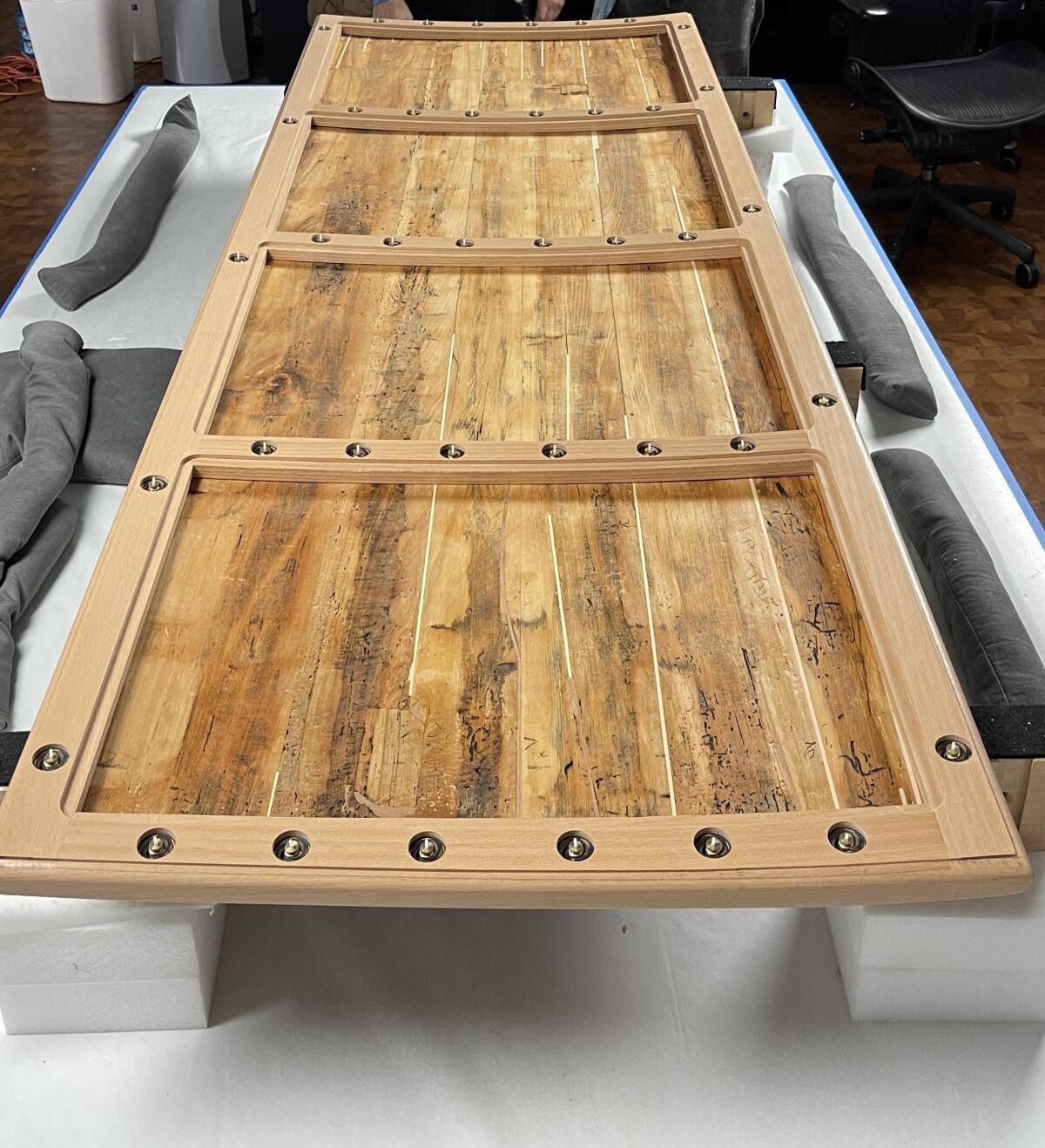
Filling in the Cranachs’ paint losses with matched, fully reversible pigments applied with tiny brushes was a more conventional procedure. The images are now strikingly vivid. Although Birkmaier added structural material and paint, he describes the entire process as ultimately subtractive: The goal was to strip away the “visual noise” that piled up over centuries of wear and tear, returning the paintings as closely as possible to what they were when Cranach laid down his brushes in 1530.
Before conservation, Adam and Eve looked imposing and elegant, if rather flat and heavy. Now they sing with airy life. The figures have a presence in space. Their drama, visually loud and clear, is enhanced.
Eve is clearly the seductive protagonist. Both figures might clutch an apple, but she alone makes direct eye contact with the viewer, surely assumed to be male. Suddenly, the form of the coiling serpent dangling from the tree by her head is seen to match the shape of her own spiraling hair, which is directly adjacent. A subtle but inescapable analogy is made between the wily devil and the guileful woman.
Circumspect Adam, that big lug, plays second fiddle, gazing listlessly but expectantly at his companion — not unlike we are. In body and soul, the formidable strength of Hercules meets a dash of Jethro Bodine’s affable naivety.
Such is the misogynist gender dynamic that operates in a deeply patriarchal society. At stake in Adam and Eve’s transgression in the Garden is the knowledge of good and evil, which embodies power. When it comes to that, she’s trouble, and he’s almost without fault. The Getty’s stunning restoration of Cranach’s art illuminates a historical continuity still being confronted today.
'Conserving Eden: Cranach's 'Adam and Eve' from the Norton Simon'
Where: J. Paul Getty Museum, 1200 Getty Center Drive, Brentwood
When: 10 a.m.–5:30 p.m., Tuesday-Friday and Sunday; 10 a.m.-8 p.m. Saturday. Jan. 23-April 21.
Info: (310) 440-7300, getty.edu
More to Read
The biggest entertainment stories
Get our big stories about Hollywood, film, television, music, arts, culture and more right in your inbox as soon as they publish.
You may occasionally receive promotional content from the Los Angeles Times.
